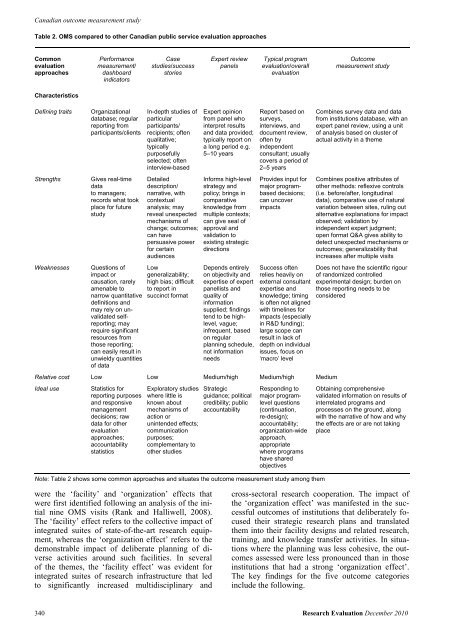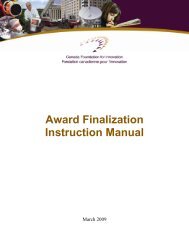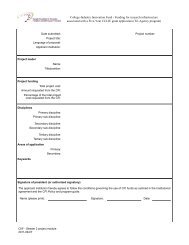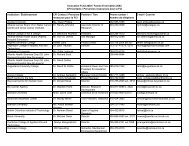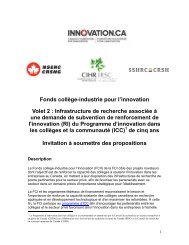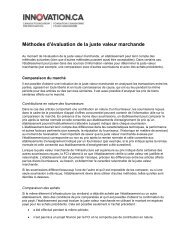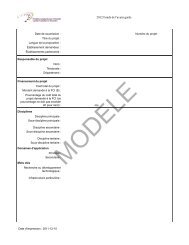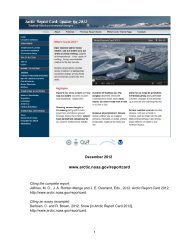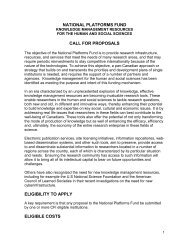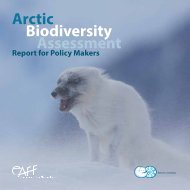Download - Canada Foundation for Innovation
Download - Canada Foundation for Innovation
Download - Canada Foundation for Innovation
Create successful ePaper yourself
Turn your PDF publications into a flip-book with our unique Google optimized e-Paper software.
Canadian outcome measurement study<br />
Table 2. OMS compared to other Canadian public service evaluation approaches<br />
Common<br />
evaluation<br />
approaches<br />
Per<strong>for</strong>mance<br />
measurement/<br />
dashboard<br />
indicators<br />
Case<br />
studies/success<br />
stories<br />
Expert review<br />
panels<br />
Typical program<br />
evaluation/overall<br />
evaluation<br />
Outcome<br />
measurement study<br />
Characteristics<br />
Defining traits<br />
Strengths<br />
Weaknesses<br />
Organizational<br />
database; regular<br />
reporting from<br />
participants/clients<br />
Gives real-time<br />
data<br />
to managers;<br />
records what took<br />
place <strong>for</strong> future<br />
study<br />
Questions of<br />
impact or<br />
causation, rarely<br />
amenable to<br />
narrow quantitative<br />
definitions and<br />
may rely on unvalidated<br />
selfreporting;<br />
may<br />
require significant<br />
resources from<br />
those reporting;<br />
can easily result in<br />
unwieldy quantities<br />
of data<br />
In-depth studies of<br />
particular<br />
participants/<br />
recipients; often<br />
qualitative;<br />
typically<br />
purposefully<br />
selected; often<br />
interview-based<br />
Detailed<br />
description/<br />
narrative, with<br />
contextual<br />
analysis; may<br />
reveal unexpected<br />
mechanisms of<br />
change; outcomes;<br />
can have<br />
persuasive power<br />
<strong>for</strong> certain<br />
audiences<br />
Low<br />
generalizability;<br />
high bias; difficult<br />
to report in<br />
succinct <strong>for</strong>mat<br />
Expert opinion<br />
from panel who<br />
interpret results<br />
and data provided;<br />
typically report on<br />
a long period e.g.<br />
5–10 years<br />
In<strong>for</strong>ms high-level<br />
strategy and<br />
policy; brings in<br />
comparative<br />
knowledge from<br />
multiple contexts;<br />
can give seal of<br />
approval and<br />
validation to<br />
existing strategic<br />
directions<br />
Depends entirely<br />
on objectivity and<br />
expertise of expert<br />
panellists and<br />
quality of<br />
in<strong>for</strong>mation<br />
supplied; findings<br />
tend to be highlevel,<br />
vague;<br />
infrequent, based<br />
on regular<br />
planning schedule,<br />
not in<strong>for</strong>mation<br />
needs<br />
Report based on<br />
surveys,<br />
interviews, and<br />
document review,<br />
often by<br />
independent<br />
consultant; usually<br />
covers a period of<br />
2–5 years<br />
Provides input <strong>for</strong><br />
major programbased<br />
decisions;<br />
can uncover<br />
impacts<br />
Success often<br />
relies heavily on<br />
external consultant<br />
expertise and<br />
knowledge; timing<br />
is often not aligned<br />
with timelines <strong>for</strong><br />
impacts (especially<br />
in R&D funding);<br />
large scope can<br />
result in lack of<br />
depth on individual<br />
issues, focus on<br />
‘macro’ level<br />
Combines survey data and data<br />
from institutions database, with an<br />
expert panel review, using a unit<br />
of analysis based on cluster of<br />
actual activity in a theme<br />
Combines positive attributes of<br />
other methods: reflexive controls<br />
(i.e. be<strong>for</strong>e/after, longitudinal<br />
data), comparative use of natural<br />
variation between sites, ruling out<br />
alternative explanations <strong>for</strong> impact<br />
observed; validation by<br />
independent expert judgment;<br />
open <strong>for</strong>mat Q&A gives ability to<br />
detect unexpected mechanisms or<br />
outcomes; generalizability that<br />
increases after multiple visits<br />
Does not have the scientific rigour<br />
of randomized controlled<br />
experimental design; burden on<br />
those reporting needs to be<br />
considered<br />
Relative cost Low Low Medium/high Medium/high Medium<br />
Ideal use<br />
Statistics <strong>for</strong> Exploratory studies Strategic<br />
Responding to Obtaining comprehensive<br />
reporting purposes<br />
and responsive<br />
management<br />
decisions; raw<br />
data <strong>for</strong> other<br />
evaluation<br />
approaches;<br />
accountability<br />
statistics<br />
where little is<br />
known about<br />
mechanisms of<br />
action or<br />
unintended effects;<br />
communication<br />
purposes;<br />
complementary to<br />
other studies<br />
guidance; political<br />
credibility; public<br />
accountability<br />
major programlevel<br />
questions<br />
(continuation,<br />
re-design);<br />
accountability;<br />
organization-wide<br />
approach,<br />
appropriate<br />
where programs<br />
have shared<br />
objectives<br />
validated in<strong>for</strong>mation on results of<br />
interrelated programs and<br />
processes on the ground, along<br />
with the narrative of how and why<br />
the effects are or are not taking<br />
place<br />
Note: Table 2 shows some common approaches and situates the outcome measurement study among them<br />
were the ‘facility’ and ‘organization’ effects that<br />
were first identified following an analysis of the initial<br />
nine OMS visits (Rank and Halliwell, 2008).<br />
The ‘facility’ effect refers to the collective impact of<br />
integrated suites of state-of-the-art research equipment,<br />
whereas the ‘organization effect’ refers to the<br />
demonstrable impact of deliberate planning of diverse<br />
activities around such facilities. In several<br />
of the themes, the ‘facility effect’ was evident <strong>for</strong><br />
integrated suites of research infrastructure that led<br />
to significantly increased multidisciplinary and<br />
cross-sectoral research cooperation. The impact of<br />
the ‘organization effect’ was manifested in the successful<br />
outcomes of institutions that deliberately focused<br />
their strategic research plans and translated<br />
them into their facility designs and related research,<br />
training, and knowledge transfer activities. In situations<br />
where the planning was less cohesive, the outcomes<br />
assessed were less pronounced than in those<br />
institutions that had a strong ‘organization effect’.<br />
The key findings <strong>for</strong> the five outcome categories<br />
include the following.<br />
340<br />
Research Evaluation December 2010


